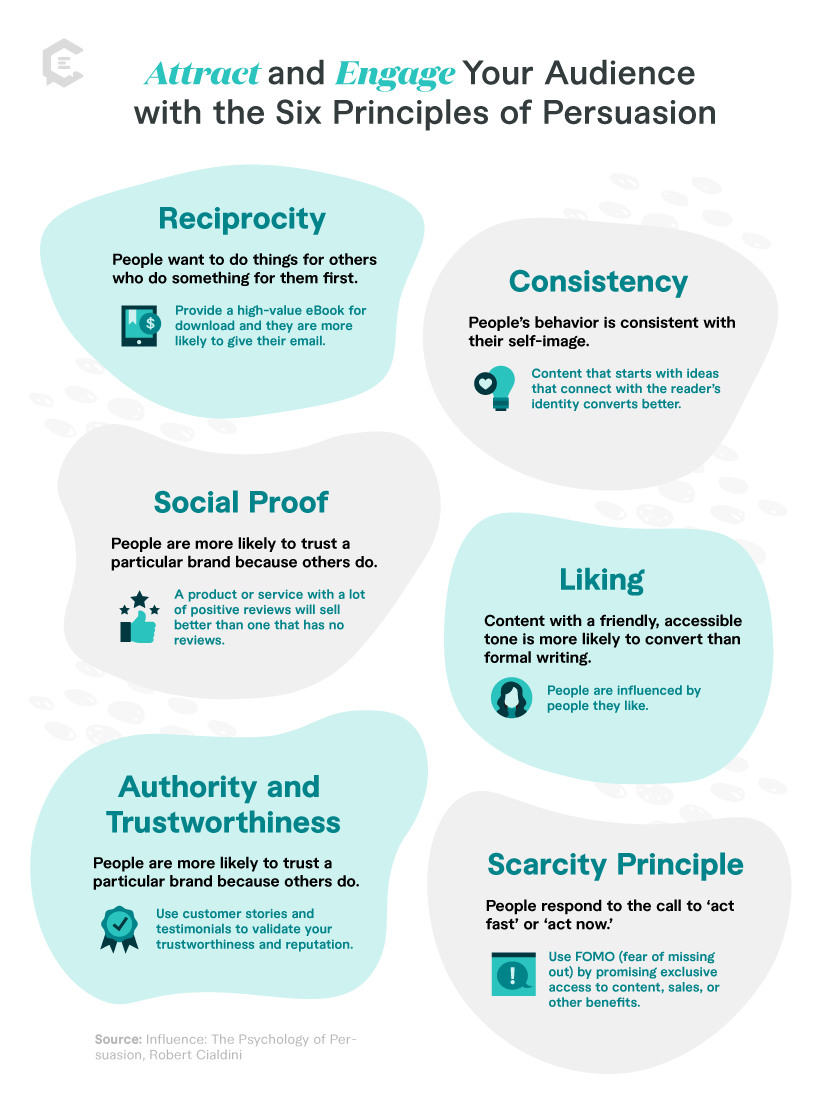As a content marketer, you know the importance of writing for persuasion. After all, if you can’t get your audience to take action, like reading your content or making a purchase, what’s the point of your work?
Every content creator relies on the skills of persuasion to successfully attract and engage with an audience. First, a casual browser has to click on a link to read.
Then, as they read, the page has to be engaging enough to keep them there. Finally, the reader must click a call-to-action button to complete the conversion.
In each case, strong content marketing writers incorporate the principles of persuasion into their writing to make the content powerful, effective, and valuable for the people they write for, their clients, and their clients’ prospects.
But even the most experienced content marketers can always learn more about how to persuade their readers. This guide will share the latest findings in the science of persuasion and show you how you can use them to create more compelling content.
The Psychology of Writing for Persuasion and Influence
Every day, the internet grows by about 252,000 new websites. Given the explosion in web access through the evolution of tablets, smartphones, and broader WiFi access, we can safely assume that millions of people worldwide live at least some part, if not a great deal, of their lives online.
The internet has lowered the entry barriers for many industries. Given all that new, fierce competition, why does any potential customer select one brand’s content over another?
The reasons behind those choices are not only of interest to content marketers and brands — they’ve been studied by social scientists for decades now.
Cialdini’s Six Principles of Influence
Robert Cialdini is the leading social scientist in the field of psychological persuasion. His 1984 book “Influence: The Psychology of Persuasion” laid the foundation for how we think about writing for persuasion today.
In his book, Cialdini introduced six principles of influence: reciprocity, consistency, social proof, liking, authority, and scarcity. Let’s look at each of these principles in depth.
A social norm is a generally accepted but unwritten rule about behavior. In this case, the reciprocity norm is the tendency of most folks to return the favor. In other words, if you want to get someone to do something for you, first do something for them.
In digital content marketing, we see this reflected in the commitment to providing valuable content to prospects and only then asking for something in return (an email address, for example, or a sign-up for a free trial period).
People will behave in ways that are consistent with their existing self-image. For example, if they consider themselves health-conscious, charitable, or committed to excellence, they are open to reading information that will support those existing self-images.
If you start your content with ideas that you know your reader feels deeply connected with, you’ll be able to pull them along as you build your case for a new thought or action.
Social proof is built on a psychological foundation of peer pressure and reinforcement. Social proof persuades users to leap of faith and trust a particular brand or message because so many others do.
Every day, examples and mechanisms of social proof on the web include:
- Comment counts.
- Social media share counts.
- High average ratings (i.e., 4.5 out of 5 on Amazon or 9.2 out of 10 on IMDB).
A subjective perspective, such as “everyone seems to be talking about Brand X shampoo,” can operate as persuasive social proof.
People are far more prone to be influenced and persuaded by people they like than those they don’t. Seems obvious, right? But this is a concept you use every day in content marketing. You’ve probably designed your brand identity to be approachable and likable, and the brand voice you use in your content is built on that foundation.
Your brand or writer’s voice feels likable when using humor, casual language, and everyday vocabulary. Of course, it doesn’t hurt to compliment your reader once in a while, either.
When writing for persuasion, you need to give readers a concrete reason to trust your brand.
The best way to build authority with your readers is to look for ways to link out to reputable, authoritative voices in your field to back up any data you cite.
Linking to other trustworthy experts in your field shows you’re smart and experienced enough to know who to trust. Hence, you (or the brand for which you’re writing) can also be trusted.
Finally, look for ways to highlight any awards or recognitions your brand has earned. Likewise, consider including your expertise and career recognition in your bio if you’re writing under your byline.
One of the most obvious sales tactics is scarcity, and it works to overcome a user’s last bit of resistance by pressuring them to act fast. If there are only 100 widgets available, or the discount code is good for today only, then those fence-sitters may be more likely to take the leap and act.
While scarcity is more common in sales than marketing, you can make use of it and the associated FOMO (fear of missing out) to persuade new users to subscribe to your list by promising them exclusive access to content or other valuable benefits (free shipping, early access to sales, special discount codes).
More Theories on Writing for Persuasion
Cialdini isn’t the only researcher to study persuasion, of course. Other valuable theories and practices have emerged over the years as well.
Conversion Theory
Conversion theory says that even if you present your message as a minority view to the general prevailing wisdom, you can sell it with consistency, confidence, and enough time.
Keep your rebuttals logically sound, well-sourced, and framed, and over time the minority view gains more focus and attention simply because it’s different. To succeed, make sure you infuse your writing with empathy for both the targeted audience and the people who hold the majority viewpoint.
Priming
In priming, the reader is introduced to a concept or notion in a preliminary or unrelated way. This way, they become more ready to agree with the idea when formally introduced.
For example, let’s say you’re crafting content that’s ultimately part of a campaign for a new line of hats. Before you even mention the hats, you write about getting ahead or being headstrong. The word head primes the reader for the concept of a hat.
In this guide, you may notice a casual mention of data that assumes you are already using data in your persuasive writing. That mention primes you, the reader, for a more extended discussion of data-driven persuasion later in the post.
If using data was a new or controversial concept for you, a casual assumption that everyone uses data in their marketing might prime you to learn more about it.
Yale University’s Attitude Change
A multidisciplinary research project by Yale University showed that persuasive communication depends on, among other things:
- Credible, attractive (i.e., warm and friendly) speakers
- Messages that don’t seem to be designed to persuade at all
- Transparent disclosure of the counter-argument (which the message then refutes)
Incorporate these findings into your content by adopting a friendly, open-minded tone of voice and including an opposing viewpoint.
Best Practices for Persuasive Writing
Here are a few more tips to keep in mind when you want your writing to be dynamic and persuasive.
Simplify and edit ruthlessly
Use assessment tools to check your content’s readability. One grade level isn’t necessarily better than another here. Instead, aim to speak to your brand’s key user personas. Use the language they use and speak to them in a way that puts them at ease.
Additionally, steer clear of jargon and slang. Delete terms of art and any vague, tired expressions. Keep your language clear, clean, and vibrant.
Aim for:
- Short descriptive sentences
- Strong, active verbs (no passive voice)
- Minimal adverbs
If you’d like some help trimming unnecessary words and tightening up your prose, check out the Hemingway App. It’s a free tool that helps you improve your writing.
Eliminate the fluff
Some experts believe longer pieces of over 3,000 words rank higher in search results for competitive keywords, but that doesn’t mean you should ramble just to hit a higher word count. Instead, it’s better to have a shorter piece that’s beautifully written, cohesive, concise, and scannable.
To pinpoint awkward phrases and grammatical errors, you can try using a plugin like Grammarly. Additionally, reading your piece aloud will help you catch errors such as passive voice, awkward phrasing, long sentences, and more.
Use the problem-agitate-solve formula
This simple but effective formula makes it easy to create persuasive content.
Start by stating a problem your target market faces, then agitate that pain point by driving home how bad it is. Finally, provide your solution as the means to alleviate their pain.
For example:
- Problem: You’re not generating enough leads from your website.
- Agitate: Your website costs you money daily, and it fails to generate leads.
- Solve: Use content marketing to generate leads.
Here’s another example:
- Problem: You’re struggling to maintain a work/life balance.
- Agitate: Working all the time takes a toll on your health, relationships, and quality of life.
- Solve: Hire a virtual assistant to take care of some of your tasks so you can have more free time.
If you know your target market and their pain points well, this simple formula can help you quickly generate everything from long-form content to social media posts when writing for persuasion.
Use data-driven content
Whenever you can, share data to back up your claims. In other words, use hard numbers and statistics to support your claims.
For example, you can write that your running shoes have a 98% customer satisfaction rate, but a reader can dismiss that as meaningless sales talk unless you can prove it with a link to a respected review site.
This is especially important if you’re trying to persuade someone to take a specific action, such as buying a product or signing up for a service. Data can be very persuasive in these situations.
For example, let’s say you run an eCommerce store that sells eco-friendly home goods. You could write a blog post titled “11 Ways to Make Your Home More Eco-Friendly” and include solid, well-researched data linked to primary sources throughout the piece to support your claims.
Including data in your content will help you make persuasive arguments and lead to more conversions.
Show your audience how well you know them
You’ve done your research and know your target market well. You know their demographics, their pain points, and their interests. Use this knowledge to your advantage by customizing your content to address their specific needs. Include specific details in your headlines and introductions that tell your target audience that this content is for them.
For example, if your target market is primarily women aged 25-35 interested in health and fitness, you could write a blog post titled “The Top 12 Health and Fitness Tips for Women Aged 25-35.
Another example: If you know your target market is small business owners struggling to generate leads, you could write a blog post titled “The Top 12 Lead Generation Tips for Small Businesses.”
If you look at the title of this piece, you may notice that it specifies it’s specifically aimed at “advanced content marketers” rather than a general audience — maybe that’s what drew you here?
By customizing your content to address the specific needs of your target market, you can show them that you understand their situation and have the solution they’re looking for.
This type of content is more likely to be persuasive because it shows that you’re in tune with your audience.
A picture is worth a thousand words
It’s a cliche because it’s true — unless your images are boring, bland, and generic. Content writers are often responsible for selecting images but may lack training in visual persuasion. Also, writers are usually paid by the word, so browsing images is unpaid work for them.
So even if you’re giving them specific visual guidelines, you could end up with bland images that don’t engage persuasively with the reader’s eye.
Images — especially featured images in blog posts — are a vital component of any piece of content. When you share content on social media, the featured image will be the most prominent part of the post.
Therefore, choose dynamic images that complement your headlines and draw people into your content is vital.
Supplemental images throughout the content can help illustrate your points, appeal to emotions, and persuade your reader.
First, make sure your images accurately reflect your target market. For instance, a common mistake is illustrating business-related content with pictures of people in suits sitting at desks when the target market may be local plumbers and restaurant owners who probably don’t wear suits or sit in offices that much.
Second, look for images with emotional content. If your story is about solving a problem, find a photo of a person who looks like they’re suffering from that problem — or enjoying the solution. If you’re selling a housecleaning product, don’t just show us the product next to a sponge. Show us the product on a coffee table, next to a smiling homeowner with their feet up, enjoying their free time in a clean home.
Tell a story
Storytelling has been a hot trend in marketing for the past decade. That’s because stories tap into our emotions and create a connection between the storyteller and the listener.
When creating content, think about ways to tell a story that will connect with your audience on an emotional level. This could be a personal story about how your product or service helped you overcome a challenge or a case study about one of your clients.
You could even tell a fictional story illustrating your target market’s problems and how your product or service can help them. The important thing is to make sure the story is relatable and resonates with your audience when writing for persuasion.
Prove your value
It’s important to show your brand’s UVP or unique value proposition. Customer stories are powerful ways to do this while building authority and providing social proof. Moreover, including a few relevant use cases can quickly demonstrate how your brand is different from the competition.
Another way to prove value in your content is to anticipate customer pushback and look for ways to counter it. Again, bolster your message here with graphics. Simple comparison charts and quotes from reviews add visual reinforcement.
Finally, remember more isn’t always better. One streamlined, well-told story that demonstrates your overall point is always better than several vague stories.
Appeal to emotions
Buyers think they make logical decisions, but almost every buying decision is emotional. Emotional appeal is what gets us to act.
Think about a large-scale natural disaster. What gets you to open your wallet and donate to the recovery fund more efficiently?
- The numbers of how many were killed, how many were injured, how many homes were lost, and how many millions of dollars were lost to the local economy. Or
- One first-person story about how first responders found and saved two children whose house had been swept away in the flood.
If you’re like most of us, the deeply personal and emotionally resonant story is the one that convinces us to act.
The lesson here is simple: Appeal to your reader’s emotional state, whatever that might be. Engage their pain points, then offer them relief and a more positive emotional state as an alternative.
Be transparent
Write so your audience understands you. It seems like simple advice, but it can mean several different things.
For example, Hemingway and Proust are both brilliant writers. Yet, it would be hard to find two famous authors whose styles differ more than theirs. Hemingway is straightforward, simple, and direct in his writing, while Proust is elaborate. They were comfortable with their style and voice, but they also knew what their audiences expected from them.
Of course, writing digital marketing content isn’t the same as writing fiction, but the point here is that when it comes to satisfying your audience and writing for persuasion, it’s important to be transparent and true to your brand voice.
Keep your writing honest and ethical
While some business owners still shy away from the idea of persuading anyone to buy their products or sign up for their list, there’s nothing dishonest about persuasive writing. It’s simply writing that states its case clearly and in ways that the audience will likely receive better. Aim for authenticity and transparency in your content marketing writing, but don’t be afraid to integrate a few persuasion techniques to reach your targeted users.
Writing for Persuasion Means Better Results
Persuasive writing is a skill that can be honed and perfected with practice. As a content marketer, understanding the psychology and science of persuasion will help you create more compelling blog posts, social media updates, and email marketing campaigns.
By applying the concepts of persuasion, you’ll be able to write content that is more likely to be read and shared and has a better chance of achieving your desired marketing goals.
ClearVoice can help you refine your content strategy and find writers who can incorporate these principles. Talk to a content specialist today to find out how we can help you achieve your goals.















